How To Catch Flounder (Plus Free PDF Catch Card)
- By: Joseph Simonds
- on
- Found In: Fishing Tips, Flounder, Inshore Fishing
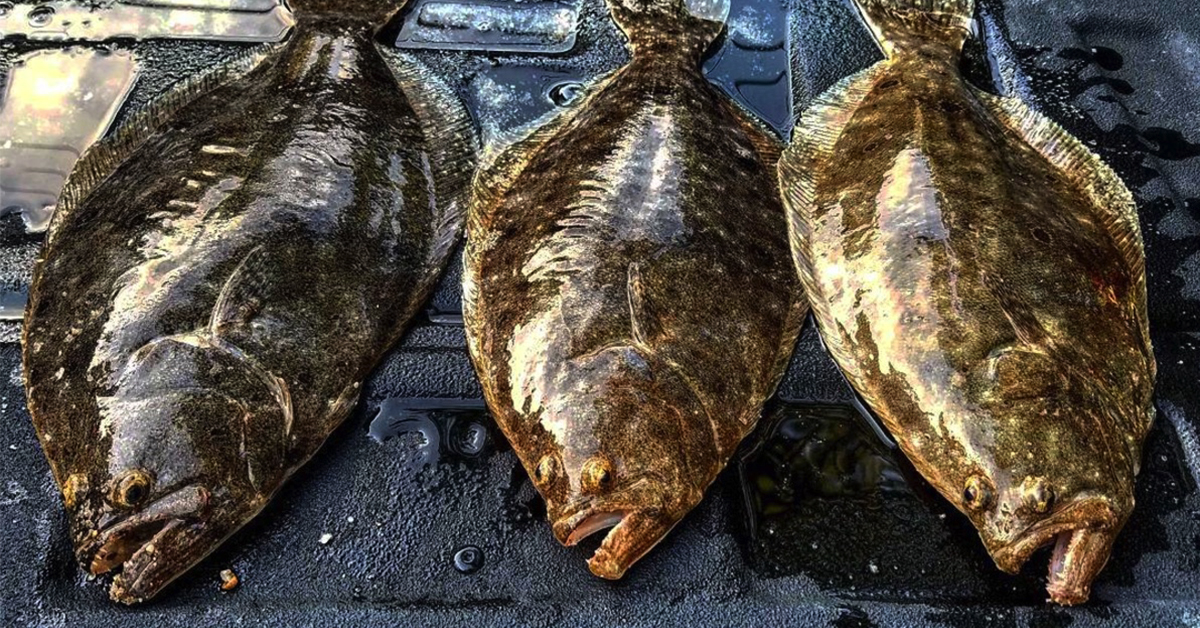
It’s flounder time!
One of our SUPER-Community members, Daniel Flinn, has written some great articles about catching sheepshead and black drum, and he’s back for more with an incredible article about how to catch flounder.
This is perfect timing, too, as springtime is when flounder head back inshore from their offshore migration homes.
You’ll learn:
- The setup you’ll need for flounder
- What types of structure to find them on
- The best baits and lures for them
- How to retrieve your lure to catch them
- And more!
Enjoy!
P.S. You can download the free PDF catch card here.
Flounder Cheat Sheet Guide
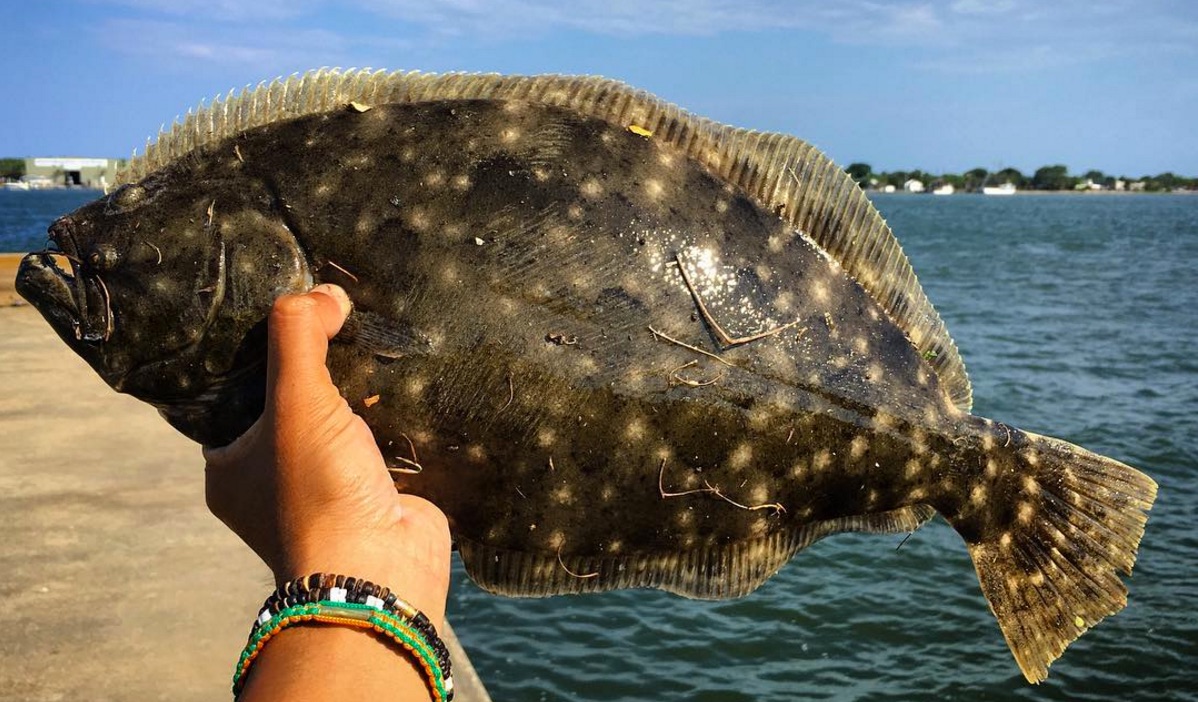
Flounder
Paralichthys Albiguttata
Where:
- Around inlets and passes
- Nearshore around oyster bars and sand bars
- Onshore around piers, docks, posts, other structure
When:
- All year round with influx February and March, migration offshore when water cools
- When the tide begins to move, they will feed
Gear:
- Light to medium spinning or bait casting tackle preferred
- Medium to stout 6 to 7-foot rod with soft tip
- 15-20 lb. braided line
- 15-20 lb. fluorocarbon leader
- # 1.0-3.0 circle hook to match bait size
- Enough weight to keep the bait near the bottom
- Carolina rig with 6-12-inch leader. Try using a split shot instead of a swivel.
Bait:
- Live bait-minnows, greenbacks, sardines, finger mullet, shrimp
- Berkeley Alive Gulp Shrimp (scented and flavored work best)
- DOA Cal
- Bucktail jig tipped with shrimp
Tactics:
- Retrieve the bait very slowly, emphasis on SLOWLY!
- Don’t jerk to set the hook. Simply begin reeling in quickly until fully hooked.
- Be patient. Wait for the bump and then count 10-15 seconds
- Keep rod tip up to feel the bite
- Hook live minnows and greenbacks in the lip
- When you think you are retrieving slowly, go even more slowly!
Trends:
- Florida flounder migrate offshore at the beginning of winter when the water
temperature is cool and will migrate inshore in the early spring.
Community:
- Check with local marina personnel who can tell you where anglers are finding them.
- Most fishing reports do not include much about this species.
- Anglers fishing near piers and docks might report flounder catches
- Talk to other anglers at the launch and also at the piers, but don’t expect them to
divulge their “secret” spots.
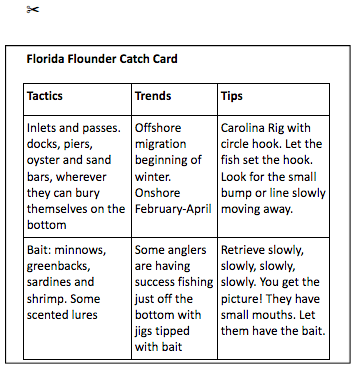
No Need To Flounder When Targeting This Favorite Fish
by Daniel Flinn
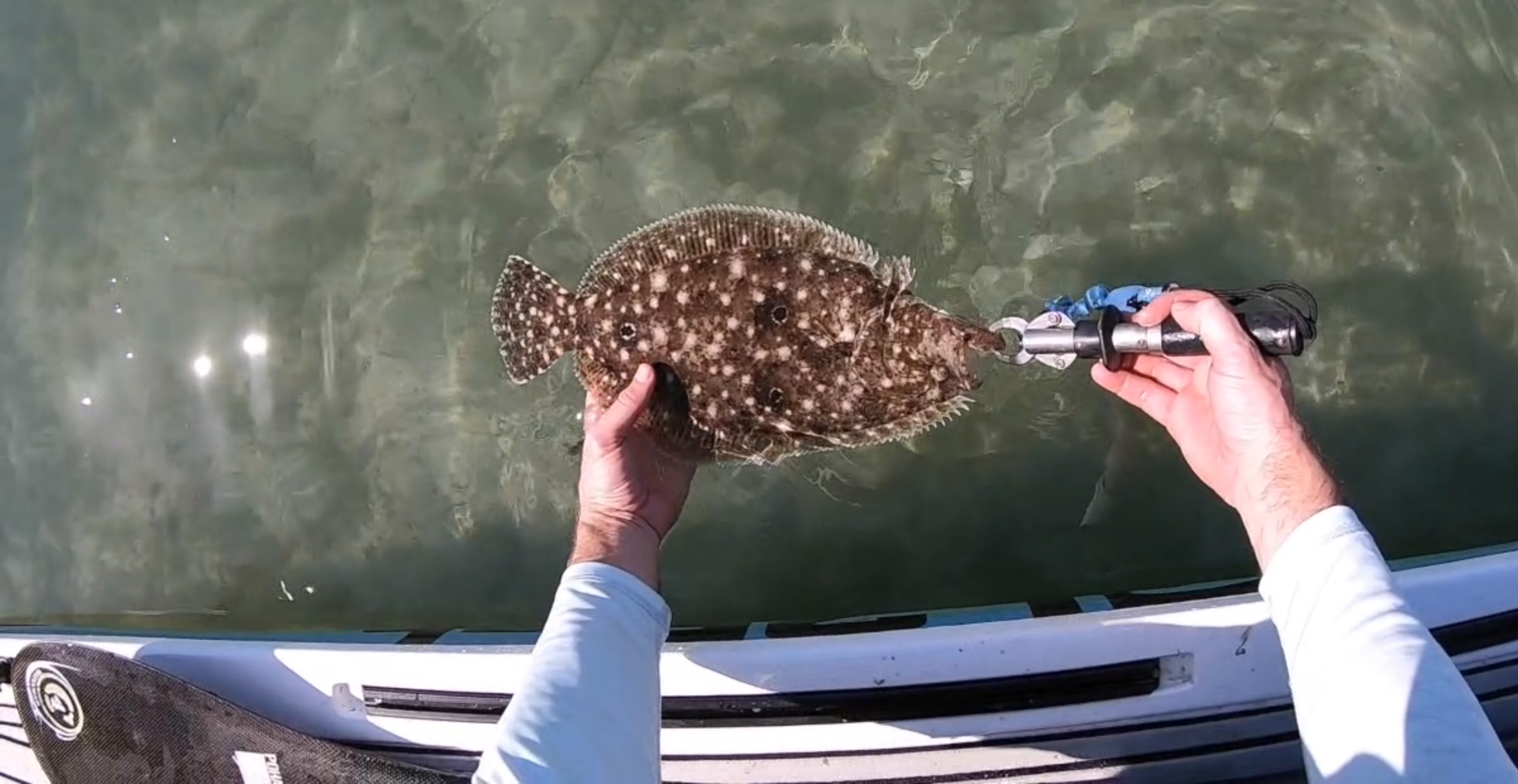
“If this flounder is legal, I’m not sharing,” said my fishing buddy, Captain Obie, as he pulled in one of the most sought-after bottom dwellers in Florida waters.
He probably took this approach because a) these fish are right up there at the top of the flavor chart or b) they are super challenging to catch.
As it turned out, he hauled in five “keepers” that day and actually filleted one for me. It didn’t take me long to learn some of the tricks of the trade.
While these wily members of the flatfish family are extremely difficult to catch for the novice, there are several things to keep in mind to maximize the chances for success.
Rigging
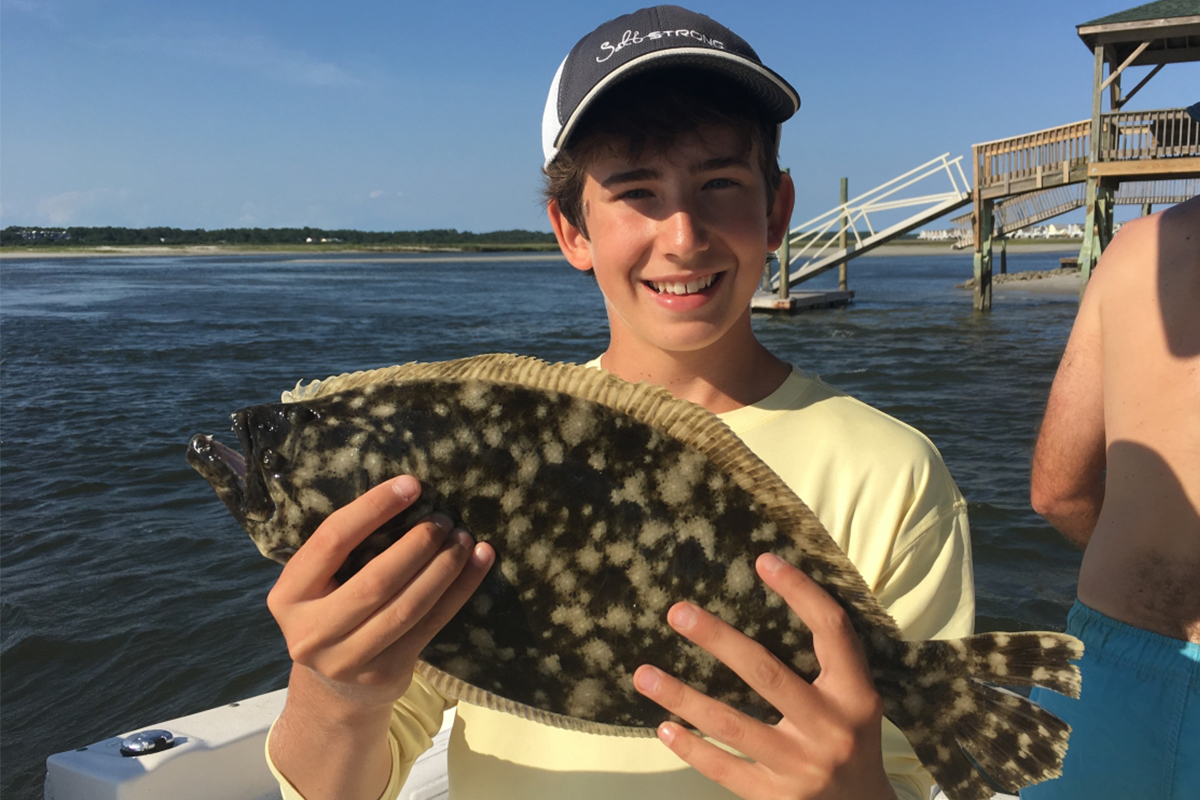
You’ll need:
- A 6-7-foot medium to heavy action rod with a fairly soft tip in order to feel the bite.
- A medium sized spinning reel or a bait casting reel in the 10-15 lb. rating
- A 1/0 to 3/0 circle hook
- Fluorocarbon leader
- 10-20 lb. braided line
The preferred set-up is a Carolina rig with just enough weight to keep the bait on the bottom.
Be sure to use fluorocarbon leader as these fish can spot mono right away.
Most Carolina rigs employ the weight ahead of a swivel with about 12 inches of fluorocarbon leader and a 1/0 to 3/0 circle hook.
Tip: another way to set up this rig substitutes a split shot in place of the swivel, making it extremely easy to adjust the leader length without changing the entire rig.
In this case, use a longer leader in order to allow for more adjustment.
10 to 20 lb. braided line is more sensitive to the bite than monofilament and is also stronger around structure with line-cutting capability.
Where To Find Them
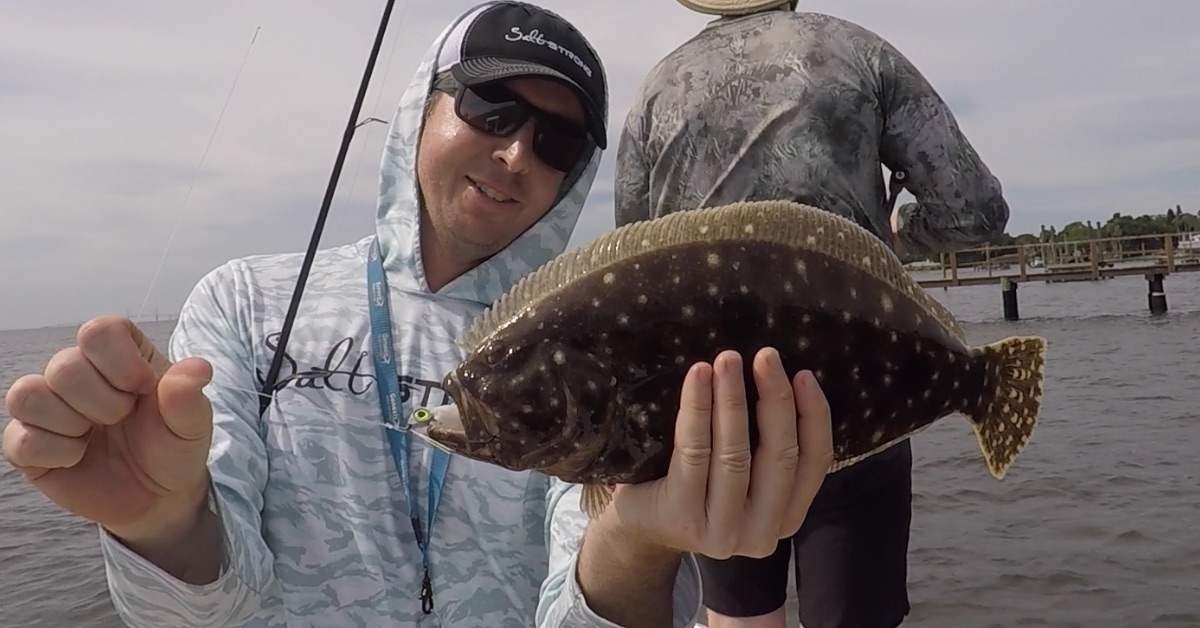
Flounder blend into the bottom, so they’re virtually impossible to sight fish.
However, you’ll be a step ahead if you seek them at inlets and creek mouths, around oyster bars, near bridges, and docks, and especially around drop-offs and sand bars.
At the beginning of spring, after flounder have finished breeding offshore, they begin to migrate back inshore.
Once they find a “home”, they tend to wait for their prey to swim past so they can dart up from the bottom and ambush their dinner.
Best Baits & Lures For Flounder
Several baits will tempt those foxy flounder.
These include live bait such as minnows, greenbacks, finger mullet, sardines and live shrimp.
Be sure to hook minnows and greenbacks in the lip to allow them to face the correct direction.
Hook shrimp through the head just in front of their eyes.
Dead bait does not work so well for flounder, but they will take lures like:
- Berkley Gulp Shrimp
- bucktail jigs tipped with shrimp
- DOA CAL
Since flounder tend to taste their food before taking it in completely, scented lures are preferred.
Incredible Underwater Flounder Footage [VIDEO]
The Retrieve
Flounder are not speed demons.
Therefore, slow is better than fast.
Allow the bait to bump very slowly along the bottom and your chances will increase.
You might feel a small bump when the fish takes the bait.
If so, be patient and let it have the bait. 10 to 15 seconds is a good bet.
If you simply feel your line moving off in one direction or another without the tell-tale bump, give it a few seconds and then simply begin reeling in.
The circle hook will engage in the corner of the fish’s mouth, thus sparing it if you decide to release it back into the water.
Keep in mind that legal length AND size should be deciding factors.
Some flounder may be legal length, but may not have enough meat to warrant keeping.
Flounder For Dinner
Most anglers will fillet flounder, exposing some of the finest white meat available with flatfish.
My captain friend, Obie, tells me that he was taught to fillet these fish so closely that you could read a newspaper through what is left over on the bones.
If you are fortunate enough to catch a couple keepers, you’ll enjoy one of the finest fish dishes out there.
How To Fillet Flounder [VIDEO]
Conclusion
Hope you enjoyed that article by Daniel Flinn!
Remember, if you want to catch flounder:
- Use light to medium spinning gear
- Use live bait, Gulp or some other scented lure
- Drag your bait slowly on the bottom
- Fish structure, including docks, bridges, passes, inlets, oyster bars and sand bars
- Wait 10-15 seconds after you feel the initial bump to let the flounder eat the bait, then reel
Feel free to download the free catch card PDF here, so you can save it to your phone or print and laminate it to take it out on the water with you.
P.S. Have a question for Daniel?
Ask him in the comments below!
Attention Flounder Fishermen:
If you consider yourself a serious fisherman and want to catch MONSTER SIZE FLOUNDER… FAST… then you’ve got to see this!
Check it out here.
Related articles:
Related categories:
STOP WASTING TIME ON THE WATER!
Do what the “SMART ANGLERS” are doing and join the Insider Club.
Here’s what you’ll receive today when you join:
- Weekly fishing reports and TRENDS revealing exactly where you should fish every trip
- Weekly “spot dissection” videos that walk you through all the best spots in your area
- Exclusive fishing tips from the PROS you can’t find anywhere else
- Everything you need to start catching fish more consistently (regardless if you fish out of a boat, kayak, or land).











When I explain flounder fishing to others I tell them, retrieve your bait very slowly, painfully slowly! Lift your bait very slowly, do not jerk your bait. Do not reel your fish in immediately or the flounder will spit the bait when it is lifted out of the water. 15 seconds will almost always insure a hook set. I recommend chartreuse colored paddle tail soft plastics especially Berkey Gulp.
How do you know where oyster beds are ?
google maps is a big help but the best way is low tide on clam day. in clear water, if not sticking up out of the water, you can easy see them.
That was very enjoyable and instructive. Skinner is the man!
Thanks for the info. I like the fillet video, I need to learn how to do that myself. I would love to see a video or article on WInter Flounder fishing. They require different rigs and techniques than Summer Flounder, so I’m told. The Winter Flounder season just opened here in NJ.
That was awesome. Thanks for posting this video. Only making us better informed fishermen. Now we gotta put in the work.
Please tell us more about buck tail and where we can buy w teasers
Loved the underwater footage, thanks!
Thanks for the info, ready to catch some this year from the kayak any tips there would help, imagine same technique but have a question about location and what is the best proximity to an Inlet would best be targeted meaning where would be best to sit within the riverside mouth I fish Sebastian Inlet inshore I have picked off a couple but in spots I would have never thought of while fishing for Redfish and Snook using 3″ Gulp shrimp. I figure it will of course be determined by the tide but need help dialing in where to be at what tide direction. Is the edge of a dropping sandbar a good spot to bounce a jig?
Metal jigs have few peers at catching flounder yet there is no mention of them in your article. I’m not referring to speed jigs, or nose assist jigs, but to a true metal finesse-type jig with a single tail hook. Examples are the Crippled Herring and the Kandlefish…Pete
Thanks for bringing this up. We’ll add this to any future revisions.
Incredible footage